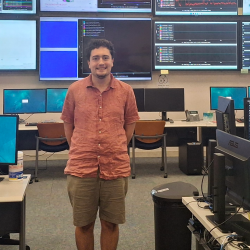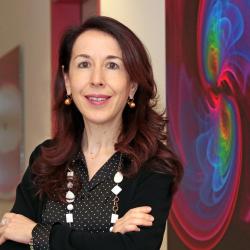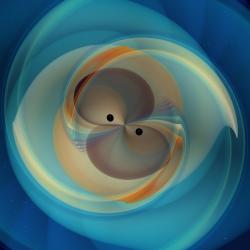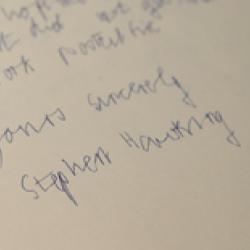Gravitational Waves
Jump to: Featured Experts and Media Contact | Photos | Upcoming Event | UMD Articles | More Information
A Brief History of Gravitatonal Waves Research at UMD
On Tuesday, October 4, 2016, the Nobel Committee for Physics announced its selection for the 2016 Nobel Prize for physics. The committee selected the first direct observation of gravitational waves, recorded by the twin detectors of the Laser Interferometer Gravitational-Wave Observatory (LIGO) on September 14, 2015, and announced at a press conference on February 11, 2016.
The effort to observe gravitational waves began at the University of Maryland more than 50 years ago, in the laboratory of the late Joseph Weber. Today, several UMD researchers are involved in the LIGO effort, and a number of emeriti professors have played key roles in the historic search as well.
The following featured experts are available for media interviews regarding the Nobel announcement:
UMD Associate Professor of Physics Peter Shawhan is a LIGO principal investigator who began working on the project as a postdoctoral researcher at Caltech. Shawhan helped design LIGO’s “blind injection” system, whereby a simulated signal would be randomly introduced into both detectors to test the team’s response and data analysis protocols. The entire LIGO group learned of these “blind injections” only after completing a significant number of analysis steps.
UMD College Park Professor of Physics Alessandra Buonanno, a LIGO principal investigator and director at the Max Planck Institute for Gravitational Physics in Potsdam, Germany, spent nearly a decade developing models to quickly and efficiently pull promising gravitational wave signals out from behind the wall of noise that obfuscates them. The process resembles the way a forensic scientist would compare a fingerprint found at a crime scene against a bank of known fingerprints.
UMD Professor Emeritus of Physics Charles Misner, a renowned gravitational theorist who co-authored the seminal text “Gravitation” with Kip Thorne and John Wheeler, mentored an entire generation of talented theorists at UMD—including many who went on to make direct or indirect contributions to the LIGO effort.
UMD Professor Emeritus of Physics Jean-Paul Richard worked on various technological improvements to resonant bar detectors like those designed by Joseph Weber in the 1950s, including more efficient resonators and transducers that could expand the detectors’ sensitivity.
UMD Professor Emeritus of Physics Dieter Brill, an accomplished gravitational theorist, also mentored a number of talented theorists. Early in his career, Brill helped build a theoretical case that gravitational waves did carry energy—and thus could be observed with a sufficiently sensitive instrument.
UMD Professor Emeritus of Physics Ho Jung Paik designed the first cooled, superconducting transducers to help boost the signal of resonant bar detectors like those designed by Joseph Weber. In theory, such upgrades were capable of improving the detectors’ sensitivity nearly a thousandfold.
UMD Professor of Physics Ted Jacobson is a gravitational theorist who was not directly involved in the LIGO project, but has a decades-long record of publications that have influenced the field and is a longstanding member of the UMD Gravitation Theory Group.
Photos
We have hi-res photos related to gravitational waves research and researchers available for download at go.umd.edu/gravwavesphotos.
UMD Articles
- "Gravitational Waves Detected 100 Years After Einstein’s Prediction"
UMD news release published on February 10, 2016 - "Gravitational Waves Detected from Second Pair of Colliding Black Holes"
UMD news release published on June 15, 2016 - "Decades After Controversial Claims, a Discovery Casts New Light on a Pioneering UMD Physicist"
UMD TERP magazine story published in the Fall 2016 issue - "The Chirps Heard Round the World"
UMD Odyssey magazine story published in the Fall 2016 issue
More Information
- Announcement of the 2016 Nobel Prize in physics
- February 11, 2016 press conference announcing the the detection of gravitational waves (Video part 1)
- February 11, 2016 press conference announcing the the detection of gravitational waves (Video part 2)
- In-depth explanation of LIGO and gravitational wave detection (Video)
- LIGO Scientific Collaboration website
- LIGO - CalTech website
- LIGO - MIT website
- Advanced LIGO - MIT website
A Brief History of Gravitational Waves Research at the University of Maryland
The long road to the detection of gravitational waves began at the University of Maryland and has wound through College Park ever since. The effort to observe gravitational waves began more than 50 years ago in the UMD laboratory of the late Joseph Weber. Widely regarded as the first to accept Einstein’s challenge, Weber launched the first concerted effort to detect gravitational waves. He began investing the majority of his time building resonant bar detectors—giant masses of aluminum weighing more than a ton that he expected would “ring” like a bell when struck with gravitational waves. Weber placed an array of sensors around the outer surface of the bars to catch any small change in the shape of the bars. Weber built one such bar detector in a small, climate-controlled building on the UMD golf course and installed a second detector at Argonne National Laboratory near Chicago. Weber claimed to have detected gravitational waves in 1969, but despite a flood of efforts, no other researchers were able to replicate his results.
Weber's tenacity and passion sowed the seeds for a vibrant gravitational research group at Maryland that carries on to this day. The successful combination of experimentation and theory at Maryland created a rich academic environment matched by few other institutions at the time.

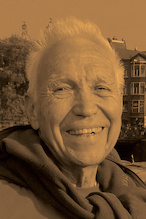 Charles Misner, well-known in the field of gravitational theory, mentored an entire generation of talented gravitational theorists at UMD, including many who went on to make direct or indirect contributions to the LIGO effort. Alumnus Richard Isaacson, Ph.D. ’67, physics, a student of Misner’s, went on to steer the LIGO funding effort as a program officer at the National Science Foundation (NSF). Alumnus Richard Matzner, Ph.D. ’67, physics, a professor of physics at the University of Texas at Austin and another one of Misner’s students, made some of the earliest calculations of what a simplified head-on collision between two black holes would look like, including the weak gravitational waves such a merger could emit.
Charles Misner, well-known in the field of gravitational theory, mentored an entire generation of talented gravitational theorists at UMD, including many who went on to make direct or indirect contributions to the LIGO effort. Alumnus Richard Isaacson, Ph.D. ’67, physics, a student of Misner’s, went on to steer the LIGO funding effort as a program officer at the National Science Foundation (NSF). Alumnus Richard Matzner, Ph.D. ’67, physics, a professor of physics at the University of Texas at Austin and another one of Misner’s students, made some of the earliest calculations of what a simplified head-on collision between two black holes would look like, including the weak gravitational waves such a merger could emit.
Weber also attracted other talented experimentalists to work with him at UMD, including Jean-Paul Richard, who came to Maryland in 1965 and is now an emeritus professor of physics. Until his retirement in 1998, Richard worked on various technological improvements to resonant bar detectors like those designed by Weber, including more efficient resonators and transducers that could expand the detectors’ sensitivity.
Dieter Brill, professor emeritus of physics at UMD who overlapped with Weber and Misner, also mentored a number of talented gravitational theorists.
In 1978, at Richard’s urging, Weber recruited a talented young postdoctoral researcher named Ho Jung Paik, who had recently finished his Ph.D. at Stanford University. Paik, now a professor emeritus of physics who continues to run an active research program at UMD, designed the first cooled, superconducting transducers to help boost the signal of resonant bar detectors like those designed by Weber. In theory, such upgrades were capable of improving the detectors’ sensitivity nearly a thousandfold.
However, laser light overcame the size problem because it could extend the detector’s baseline from a few meters to several kilometers. As a result, NSF began funding interferometer work in a major way in the 1980s and eventually constructed the Laser Interferometer Gravitational-Wave Observatory (LIGO). Weber worked on some of the earliest laser interferometer designs, with help from the late Robert Forward, B.S. ’54, Ph.D. ’65, physics, who was among the first to clearly articulate the potential of laser interferometers to detect a wider range of frequencies compared with resonant bar detectors. Despite the promise offered by laser technology, Weber remained dedicated to his resonant bar detectors until his death in 2000.
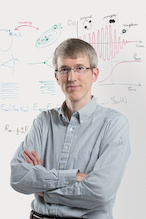 Recognizing a need for UMD to be involved in the LIGO effort, the university hired Peter Shawhan in 2006. Now a LIGO principal investigator and associate professor of physics at UMD, Shawhan had been working on the project for seven years as a postdoctoral researcher at Caltech. One crucial innovation the LIGO team devised, with Shawhan’s help, was an elaborate “fire drill” system. Unbeknownst to other team members, a simulated signal would be randomly introduced into both detectors to test the team’s response and—crucially—data analysis protocols. The entire LIGO group learned of these “blind injections” only after completing a significant number of analysis steps.
Recognizing a need for UMD to be involved in the LIGO effort, the university hired Peter Shawhan in 2006. Now a LIGO principal investigator and associate professor of physics at UMD, Shawhan had been working on the project for seven years as a postdoctoral researcher at Caltech. One crucial innovation the LIGO team devised, with Shawhan’s help, was an elaborate “fire drill” system. Unbeknownst to other team members, a simulated signal would be randomly introduced into both detectors to test the team’s response and—crucially—data analysis protocols. The entire LIGO group learned of these “blind injections” only after completing a significant number of analysis steps.
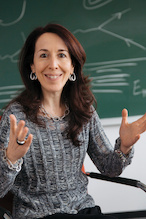 Alessandra Buonanno, a LIGO principal investigator and College Park Professor of Physics at UMD who also has an appointment as director at the Max Planck Institute for Gravitational Physics in Potsdam, Germany, and her collaborators spent nearly a decade developing models to quickly and efficiently pull promising gravitational wave signals out from behind the wall of noise that obfuscates them. The process resembles the way a forensic scientist would compare a fingerprint found at a crime scene against a bank of known fingerprints.
Alessandra Buonanno, a LIGO principal investigator and College Park Professor of Physics at UMD who also has an appointment as director at the Max Planck Institute for Gravitational Physics in Potsdam, Germany, and her collaborators spent nearly a decade developing models to quickly and efficiently pull promising gravitational wave signals out from behind the wall of noise that obfuscates them. The process resembles the way a forensic scientist would compare a fingerprint found at a crime scene against a bank of known fingerprints.
On September 14, 2015, LIGO directly detected gravitational waves for the first time. The gravitational "chirp" resulted from the cataclysmic merger of two black holes 1.3 billion years ago, which created a shock of gravitational energy that warped space and time along its path. A second event, the merger of two smaller black holes, set off the LIGO detectors again on December 26, 2015. The first event offered a look at what is known as the “ringdown” phase—the moment that immediately follows a black hole merger and the initial spike of gravitational energy, when the two objects quickly settle into a stable form as a new, larger black hole. Alumnus C.V. Vishveshwara, Ph.D. ’68, physics, a theoretical physicist and director emeritus of the Jawaharlal Nehru Planetarium in Bangalore, India, who is best known for proving that non-rotating black holes are stable, first predicted the ringdown phase in the early 1970s.
At the February 2016 press conference when the LIGO Scientific Collaboration and the NSF announced the first detection of gravitational waves, LIGO Co-founder Kip Thorne of Caltech name-checked Weber as a pioneer of the search for gravitational waves. It was an expected and appropriate nod, given Weber’s undeniable contributions to the field.
The preceding text was excerpted from "The Chirps Heard Round the World," a story published in the fall 2016 issue of UMD's Odyssey magazine. To read the story in its entirety, visit https://cmns.umd.edu/news-events/news/chirps-heard-round-world.







